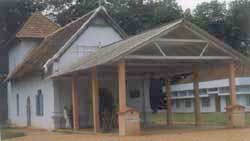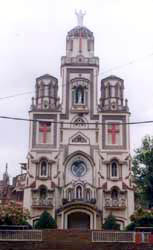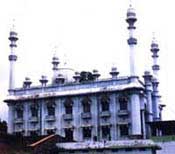|
|
| |
Christian
Churches St. Mary's old church (Pazhayapalli alias Akkara Palli) was
built and consecrated on 8th Sept. 1449. To get the right perspective
it should be remembered that the Portuguese landed in Kodungalloor 50
years later i.e. in 1498 and that St. Peter' cathedral in Rome was
consecrated in 1590 and St. Paul's Church in London only in 1710 !
As has been stated
earlier, the Christians of Kanjirapally under the leadership of Thommi Mappila of Periyaveettil
(Valiyaveettil) enjoyed royal Patronage to construct this church. The
first church was built in wood and stone and might have been renewed
three or four times. The present church might have been constructed
and the attractive crucifix venerated at the altar after the advent of
the Portuguese and Latin missionaries. Before 1500 there was no
crucifix in the Malabar church. Church architecture as any other
religious architecture, had its humble origin and slow development.
Further, there is no tradition of erecting churches as monuments of
achievements. Hence we do not see churches comparable with the
gigantic temples of Mahabalipuram or Konark or the Muslim architecture
of Delhi and Agra. Likewise, we do not have church complexes as we
have elaborate temple complexes in many places.
Kanjirapally under the leadership of Thommi Mappila of Periyaveettil
(Valiyaveettil) enjoyed royal Patronage to construct this church. The
first church was built in wood and stone and might have been renewed
three or four times. The present church might have been constructed
and the attractive crucifix venerated at the altar after the advent of
the Portuguese and Latin missionaries. Before 1500 there was no
crucifix in the Malabar church. Church architecture as any other
religious architecture, had its humble origin and slow development.
Further, there is no tradition of erecting churches as monuments of
achievements. Hence we do not see churches comparable with the
gigantic temples of Mahabalipuram or Konark or the Muslim architecture
of Delhi and Agra. Likewise, we do not have church complexes as we
have elaborate temple complexes in many places.
The construction of the Sacred place of worship was normally conditioned by the need of the locality, the economic condition, the material available, the technical know-how, the cultural background, and the foreign contacts. The general plan of Christian churches all over the world is basically the same, sanctum with an altar and a nave for the congregation. The first structural church might have been built in a very simple form, for, the requirement was very limited and the community was weak, numerically and economically. So they constructed a rectangular hall with wood and bamboo covered with attached roof. A raised platform on one side served as the sanctum. This incidentally tallies with the ancient village churches in the Western world. At this stage, the distinction between the sanctum and the nave was not very clear in the minds of the people. There was one main entrance door in front of the church and some small holes for ventilation. Even when they changed the material from wood to stone the plan remained the same. The small church on the top of Malayattoor and the church at Puthukad are good examples of these type of churches.
In the second stage a major change took place in the minds of the community which had by now developed considerably. The nave and the sanctum were clearly separated. The sanctum had a slanting square roof. There were two small windows on the two sides. The nave had a main entrance and one side entrance on each side. The church at Kuruvilangad is an example of this type.
The most interesting aspect of the Christian architecture in Kerala is that it is a living entity. Even though it was influenced from time to time by Buddhist, Jain, Hindu and Western forms of architecture, it has maintained its originality and character down the centuries to the present day. The imagination of the people is always guided by the historical, religious and social background in which they live.
“Aruli
Kalpikkayil, Nammude Thommi Mappila Kandennal, Thankalude pallikku
vilakku vaippinu vakayayittu chothanayum vaipichu, Kudam onninu
arakkal edangazhi velichenna veetham (2 thudam) eduthukollumaru
kalpichu tharavum ezhuthi koduthithu. Kollam 697 - am andu Kanni
Njayar 4-am theeyathi Kanjirapally Idathil irunnaruli kalpicha vaikku
ithu (podivu)” (Malayalam)
This chothana is still retained
in the church treasury.
In AD 1750 (ME 925) Marthanda Varma Maharaja or Travancore sent his army led by Ramiyan Delava, to the North with the object of extending his Kingdom. They defeated Thekkumkoor army at Aranmula and annexed the country to Travancore. Kanjirapally then became part of Travancore and the capital of Thekkumkoor and the palace at Kanjirapally became part of history.
 St.
DOMINIC'S CATHEDERAL KANJIRAPALLY
St.
DOMINIC'S CATHEDERAL KANJIRAPALLY
St. Dominic's Cathedral one furlong South West of Kanjirapally Akkara
Pally was built in 1826 in 'Vayampu Purayidam' near the Western bank
of Chittar. The new church and the old church remained as two parish
churches for 18 years and in 1842, both the Parishes were amalgamated
by an order of Mar Frencheeske Savioru Desyana, Vicar Apostolic of
Varapuzha. St. Dominic's church was raised to the position of a Forane
church on July 25, 1919. The reconstruction of this church began in
1945 and was completed in 1961. The 150th anniversary of St. Dominic's
Forane church was celebrated in 1977. When the new diocese of
Kanjirapally came into being on 17th March 1977, St. Dominic's Forane
church was elevated to the status of a Cathedral. The new Bishop Mar
Joseph Powathil assumed charge of Kanjirapally Diocese on 12th May
1977. Rev. Dr. (Prof.) Xavier Koodapuzha is the present Vicar of the
cathedral.
GANAPATHIYAR KOVIL
NAINARU MOSQUE

